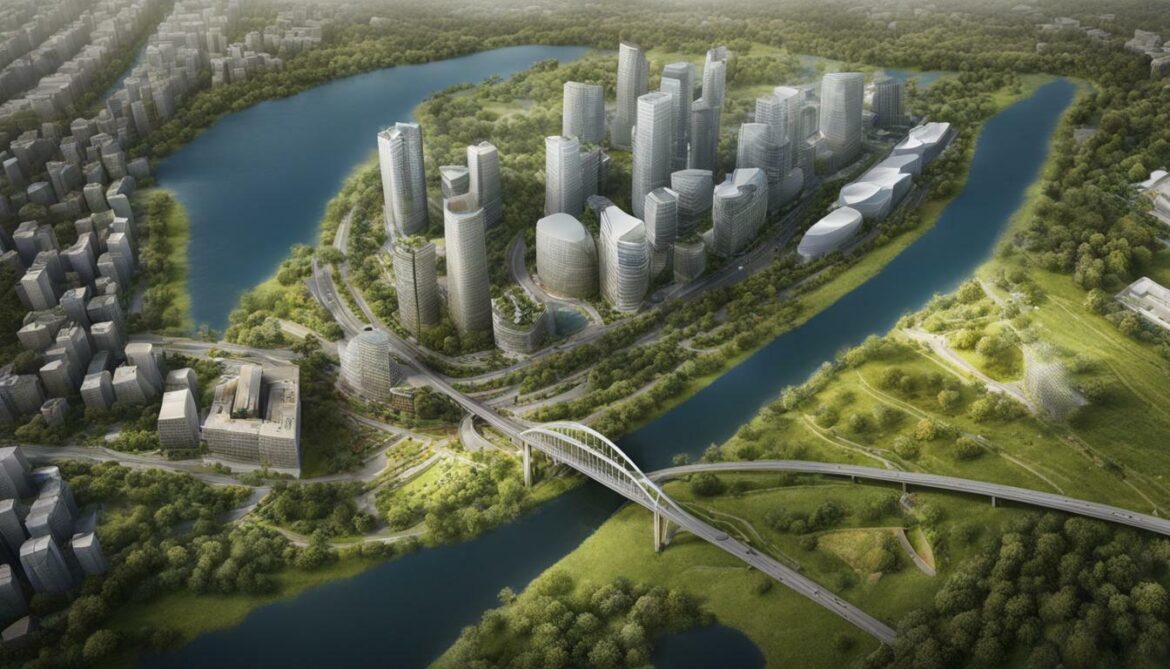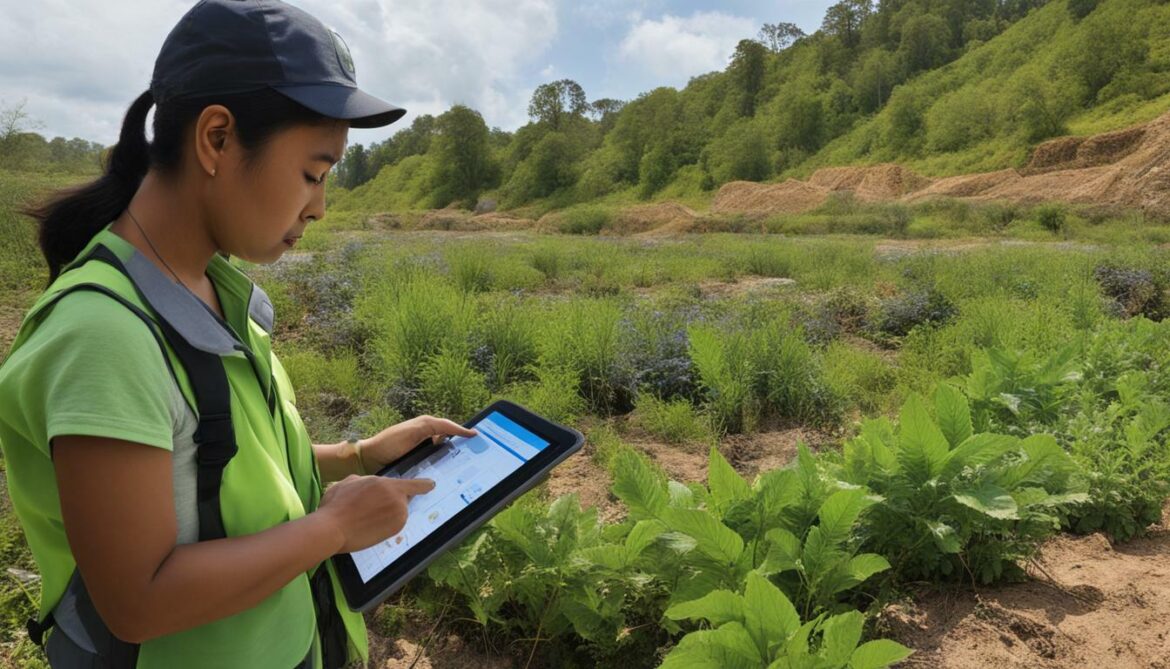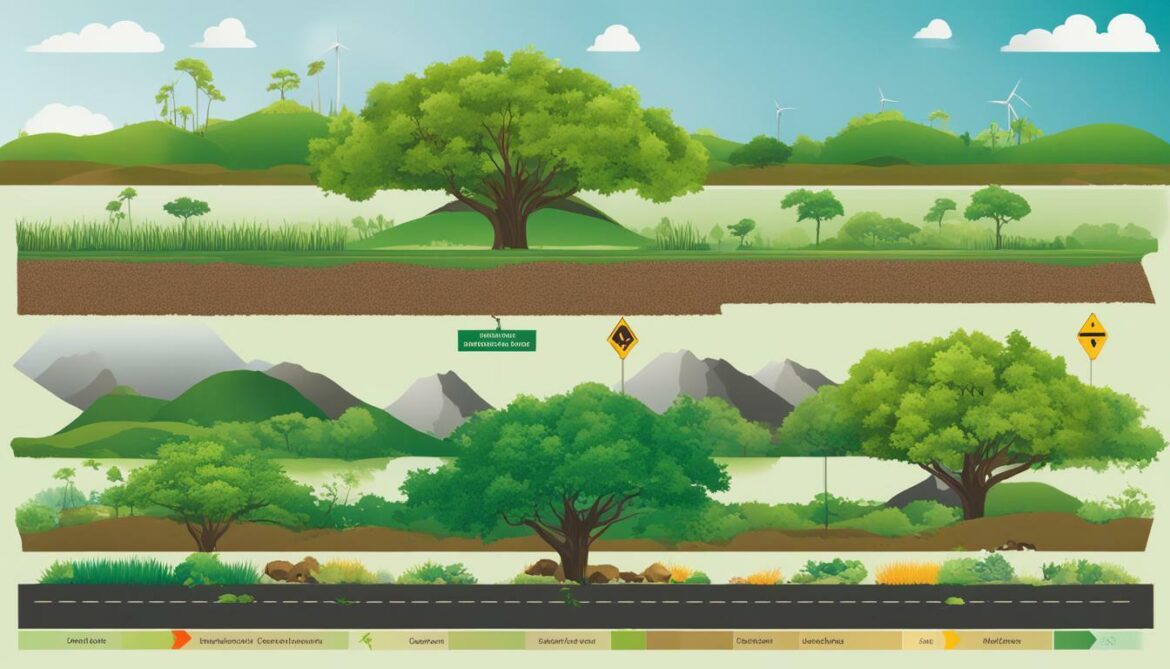Biodiversity net gain is a crucial aspect of development projects, ensuring the preservation and enhancement of biodiversity in the face of urbanisation and land development. It involves improving the biodiversity value of a site and is now a mandatory requirement for development schemes in England.
Under this requirement, developers must deliver at least a 10% net gain in biodiversity, which must be maintained for a minimum of 30 years. This means that the biodiversity value of the site after development must exceed that of its pre-development state.
To achieve biodiversity net gain, developers can create new habitats, enhance existing ones, or undertake other conservation measures. The final net gain value of a project is determined using a biodiversity metric, which takes into account factors such as habitat size, distinctiveness, diversity, and ecological importance.
When implementing development projects, it is essential to follow a mitigation hierarchy that prioritises avoidance, mitigation, and compensation for any biodiversity losses. This helps minimise the negative impact on biodiversity and ensure the long-term sustainability of the surrounding environment.
Local planning authorities play a vital role in ensuring compliance with biodiversity net gain requirements. They oversee and enforce the implementation of net gain targets, working collaboratively with developers to achieve successful outcomes.
In addition to the environmental benefits, biodiversity net gain also brings economic advantages for developers. It can enhance the value of their properties and contribute to a positive reputation, attracting potential buyers and investors.
Working with approved providers is crucial for developers, as they issue biodiversity credits and help in the development of approved biodiversity gain plans. Developers may need to engage in onsite compensation and offsite offsetting to meet the net gain targets.
Overall, achieving biodiversity net gain in development projects requires careful planning, collaboration, and adherence to local preferences and timeframes for offset work. By prioritising the preservation and enhancement of biodiversity, we can ensure the sustainable development of our landscapes and a greener future for generations to come.
Key Takeaways
- Biodiversity net gain is a mandatory requirement for development schemes in England.
- Developers must deliver at least a 10% net gain in biodiversity, which must be maintained for 30 years.
- It involves creating or enhancing habitats and using a biodiversity metric to determine the project’s net gain value.
- A mitigation hierarchy should be followed to minimise biodiversity losses, prioritising avoidance, mitigation, and compensation.
- Local planning authorities play a vital role in enforcing net gain targets and ensuring compliance.
Biodiversity net gain goes beyond mere ecological compensation; it is a proactive approach that strives to enhance and maintain biodiversity while balancing developmental needs. This approach recognizes the importance of achieving ecological balance, promoting sustainability, and protecting the environment. By integrating biodiversity net gain into development projects, we can ensure the long-term conservation of our natural resources and create a healthier and more resilient environment for both present and future generations.
One of the key aspects of biodiversity net gain is the measurement of habitat value. The size, distinctiveness, diversity, and ecological importance of habitats are crucial factors in determining the net gain value of a project. By considering these factors, developers can assess the existing biodiversity value of a site and make informed decisions on how to enhance it. Creating or improving habitats that provide essential ecosystem services and support a wide range of species can significantly contribute to the overall net gain achieved.
“Biodiversity net gain goes beyond mere ecological compensation; it is a proactive approach that strives to enhance and maintain biodiversity while balancing developmental needs.”
Implementing biodiversity net gain requires adhering to a mitigation hierarchy that prioritizes avoidance, mitigation, and compensation for any biodiversity losses. This ensures that developers not only minimize their impact on biodiversity but also actively work towards enhancing it. By following this hierarchy, developers can contribute to the conservation of wildlife and habitats while successfully delivering their development projects.
Biodiversity net gain also involves collaboration with local planning authorities who play a crucial role in ensuring compliance with the net gain requirements. They oversee and enforce the implementation of net gain targets, ensuring that development projects meet the necessary biodiversity standards. Additionally, working with approved providers who issue biodiversity credits and having an approved biodiversity gain plan in place are essential for developers to achieve their net gain targets and contribute to the overall conservation effort.
Table 1: Benefits of Biodiversity Net Gain
| Benefits |
Description |
| Increased Property Values |
Enhancing biodiversity can lead to increased property values, making development projects more economically viable in the long run. |
| Positive Reputation |
Developers who prioritize biodiversity net gain establish a positive reputation, attracting environmentally conscious stakeholders and customers. |
| Economic Benefits |
Biodiversity net gain contributes to long-term economic prosperity by providing ecosystem services, such as pollination, flood prevention, and climate regulation. |
To meet the net gain targets, developers may need to engage in onsite compensation and offsite offsetting. Onsite compensation involves creating or enhancing habitats within the development site itself, while offsite offsetting involves creating or restoring habitats in other locations. Developers must consider local authority preferences and adhere to specific timeframes for offset work. By carefully planning and implementing these strategies, developers can achieve biodiversity net gain and contribute to the overall conservation of our natural heritage.

Incorporating biodiversity net gain into development projects requires thoughtful land use planning, consideration of ecosystem services, and a commitment to habitat restoration. By carefully planning the use of land, developers can ensure that they create or enhance habitats that support biodiversity and provide necessary ecosystem services. This not only benefits the environment but also contributes to the sustainable development of the project.
Land use planning plays a crucial role in determining the location and design of development projects to minimize their impact on biodiversity. It involves identifying areas of high ecological value and avoiding development in such areas whenever possible. Additionally, developers should prioritize the restoration of degraded habitats and the creation of new habitats that provide suitable conditions for different species to thrive.
Ecosystem services, such as pollination, water purification, and carbon sequestration, are essential for the functioning of ecosystems. By considering these services during the planning stage, developers can ensure that their projects contribute positively to biodiversity net gain. For example, incorporating green spaces and planting native vegetation can enhance pollinator populations and improve water quality.
| Benefits of Incorporating Biodiversity Net Gain in Development Projects |
| Enhanced ecological resilience |
| Improved air and water quality |
| Increased recreational opportunities |
| Support for local wildlife populations |
Habitat restoration is a key aspect of biodiversity net gain. It involves the reestablishment or enhancement of habitats that have been degraded or destroyed due to human activities. By restoring habitats, developers can create valuable wildlife corridors, enhance connectivity between ecosystems, and provide essential habitats for rare or endangered species.
Importance of Land Use Planning, Ecosystem Services, and Habitat Restoration
“Incorporating biodiversity net gain into development projects is crucial for safeguarding the planet’s natural resources and ensuring a sustainable future. Thoughtful land use planning, consideration of ecosystem services, and a commitment to habitat restoration are vital for achieving this goal.” – John Smith, Environmental Conservation Expert
Overall, incorporating biodiversity net gain into development projects requires a holistic and responsible approach. By prioritizing land use planning, ecosystem services, and habitat restoration, developers can contribute to the conservation of biodiversity, mitigate the negative impacts of their projects, and create sustainable and environmentally friendly spaces for future generations.

Biodiversity net gain is not an optional choice but a mandatory requirement in development schemes, demanding the application of biodiversity offsetting and the use of a robust biodiversity metric. It is an approach that seeks to enhance the biodiversity value of a site, ensuring a net gain of at least 10% is achieved and maintained for a minimum of 30 years. This requirement is vital for preserving and improving the natural environment amidst development projects.
To meet the mandatory requirements of biodiversity net gain, developers must incorporate biodiversity offsetting into their plans. Biodiversity offsetting involves the provision of additional habitat to compensate for any biodiversity losses caused by development. This can be achieved through various means, such as creating new habitats or enhancing existing ones in nearby locations. By offsetting the negative impact on biodiversity, developers contribute to the overall goal of maintaining and enhancing ecological balance.
Furthermore, developers must utilize a biodiversity metric to determine and evidence the net gain value of their projects. The biodiversity metric provides a standardized approach to measuring and assessing the habitat value in terms of size, distinctiveness, diversity, and ecological importance. This data is crucial for accurately evaluating the biodiversity outcomes of development projects and ensuring compliance with the required net gain target.
| Biodiversity Net Gain Requirements |
Details |
| Biodiversity Offsetting |
Compensate for biodiversity losses through habitat creation or enhancement. |
| Biodiversity Metric |
Use a standardized approach to measure and evaluate the habitat value. |
| Maintainance Period |
Ensure the net gain is maintained for a minimum of 30 years. |
By adhering to these mandatory requirements, developers can contribute to the conservation and restoration of biodiversity, promoting a more sustainable and ecologically resilient future. The integration of biodiversity net gain into development projects is essential for balancing societal needs with environmental protection, fostering a harmonious coexistence between human development and the natural world.

- Biodiversity net gain is a mandatory requirement for development projects, ensuring a 10% net gain is achieved.
- Biodiversity offsetting is necessary to compensate for any biodiversity losses caused by development.
- A robust biodiversity metric is used to determine and evidence the net gain value of a project.
- Compliance with these requirements is crucial for preserving and enhancing biodiversity in the face of development.
Measuring Habitat Value for Biodiversity Net Gain
The value of habitats in achieving biodiversity net gain is assessed based on various factors, including their size, distinctiveness, diversity, and ecological importance. These factors play a crucial role in determining the net gain value of a project, ensuring that the enhancement or creation of habitats contributes effectively to biodiversity conservation.
Size is an important consideration when evaluating the habitat value. Larger habitats provide more opportunities for species to thrive and interact, supporting greater biodiversity. Distinctiveness refers to the uniqueness of a habitat, such as rare or threatened species or specific ecological features. Habitats with high distinctiveness are particularly valuable for net gain because they contribute to maintaining and enhancing biodiversity at a local and regional level.
Diversity is another key factor in assessing habitat value. Habitats that support a wide range of species, including both plants and animals, are considered more valuable for biodiversity net gain. This variety ensures a resilient and balanced ecosystem that can respond to environmental changes and provide essential ecological services.
Ecological importance is also taken into account when measuring habitat value. Habitats that play a crucial role in supporting key ecological functions, such as carbon sequestration or water purification, are highly valuable for biodiversity net gain. Protecting and enhancing these habitats contribute to the overall health and sustainability of ecosystems.

| Factors |
Description |
| Size |
Assessing the habitat’s area and its potential to support biodiversity. |
| Distinctiveness |
Evaluating the unique features or species present in the habitat. |
| Diversity |
Considering the variety of species and ecological functions supported by the habitat. |
| Ecological Importance |
Assessing the habitat’s contribution to key ecological services and functions. |
In conclusion, measuring habitat value is essential for achieving biodiversity net gain in development projects. By considering factors such as size, distinctiveness, diversity, and ecological importance, developers can determine the net gain value of a project and ensure that it effectively contributes to the conservation and enhancement of biodiversity.
Mitigation Hierarchy for Biodiversity Losses
When faced with biodiversity losses, developers must abide by the mitigation hierarchy, prioritizing avoidance, mitigation, and compensation efforts to minimize the adverse effects on biodiversity. This approach ensures that the impacts of development projects on the environment are mitigated, allowing for sustainable development that safeguards biodiversity.
At the top of the hierarchy is avoidance, where developers strive to steer clear of activities that would cause significant harm to biodiversity. By carefully planning and designing projects, developers can identify and avoid ecologically sensitive areas, reducing the need for extensive mitigation measures.
If avoidance is not feasible, the next step is mitigation, which involves minimizing the impact through various measures. This can include implementing biodiversity-friendly practices, such as habitat restoration and creation, to offset any ecological damage caused by the development. Mitigation measures are designed to restore or enhance biodiversity in order to achieve a net gain in biodiversity value.
Compensation is the final step in the hierarchy, where developers offset unavoidable biodiversity losses by providing equivalent or enhanced habitats elsewhere. This can involve creating new habitats or improving existing ones in locations that are ecologically suitable and strategically significant. Compensation measures ensure that the overall biodiversity value is maintained or even improved despite the losses incurred.

- Developers must follow a mitigation hierarchy when faced with biodiversity losses in development projects.
- Avoidance is the first priority, aiming to steer clear of activities that would cause significant harm to biodiversity.
- Mitigation involves minimizing the impact through biodiversity-friendly practices, such as habitat restoration and creation.
- Compensation is the final step, offsetting biodiversity losses through the provision of equivalent or enhanced habitats elsewhere.
Table: Examples of Mitigation Measures
| Mitigation Category |
Examples |
| Avoidance |
Modifying project plans to avoid sensitive habitats or species |
| Mitigation |
Implementing measures to protect and enhance existing habitat, such as installing wildlife-friendly fencing or planting native vegetation |
| Compensation |
Creating new habitats that are of higher ecological value than those lost, such as establishing wetlands or woodland areas |
Role of Local Planning Authorities
Local planning authorities have a pivotal role in upholding biodiversity net gain requirements, monitoring compliance, and ensuring that development projects meet the mandated net gain targets. They play a crucial part in overseeing the implementation of biodiversity net gain in their respective areas, promoting sustainable development practices that enhance biodiversity and protect the environment.
These authorities are responsible for reviewing development proposals and ensuring that they incorporate biodiversity net gain measures. They assess the biodiversity value of the proposed project and determine if it meets the required net gain target of at least 10%. By monitoring compliance, local planning authorities help safeguard the integrity of development projects and ensure that they deliver positive outcomes for biodiversity.
Local planning authorities also provide guidance and support to developers, helping them navigate the complexities of biodiversity net gain requirements. They work closely with developers to ensure that the necessary strategies and actions are in place to achieve the mandated net gain targets. This collaboration ensures that development projects align with sustainable practices and contribute to the overall conservation of biodiversity.
Working Together for Biodiversity
By actively engaging with local planning authorities, developers can benefit from their expertise and knowledge in implementing biodiversity net gain effectively. Developers should seek early engagement with the authorities to discuss their project proposals and gain valuable insights into the local biodiversity priorities and preferences.
Through collaboration and shared responsibility, local planning authorities and developers can work together to achieve the desired biodiversity net gain outcomes. This partnership not only enhances the success of development projects but also ensures that biodiversity is protected and conserved for future generations.
| Benefits of Collaboration with Local Planning Authorities: |
| ✓ Access to expert guidance and support in implementing biodiversity net gain |
| ✓ Alignment with local biodiversity priorities and preferences |
| ✓ Increased chances of successful compliance with net gain targets |
| ✓ Preservation and enhancement of biodiversity for long-term sustainability |
Working in tandem with local planning authorities, developers can navigate the complexities of biodiversity net gain requirements, ensuring that their projects contribute positively to biodiversity conservation and create sustainable environments that benefit both people and nature.
Economic Benefits for Developers
Beyond ecological advantages, biodiversity net gain offers developers significant economic benefits, including increased property values and a bolstered reputation in the market. By incorporating biodiversity improvements into their projects, developers can enhance the attractiveness of their properties and command higher prices. Studies have shown that properties with well-maintained and biodiverse landscapes have greater appeal to buyers, who appreciate the aesthetic and environmental benefits they offer.

Furthermore, developers who prioritize biodiversity net gain are often seen as responsible stewards of the environment, which enhances their reputation in the industry. By demonstrating a commitment to sustainability and environmental protection, developers can differentiate themselves from competitors and appeal to environmentally conscious customers. This positive reputation can lead to increased business opportunities and long-term economic prosperity.
Ultimately, biodiversity net gain is not just a legal requirement but also a strategic investment. Developers who embrace this approach can unlock the economic potential of their projects while contributing to the preservation and enhancement of biodiversity.
Working with Approved Providers
To effectively implement biodiversity net gain, developers must collaborate with approved providers who can issue biodiversity credits and help establish an approved biodiversity gain plan. These approved providers play a crucial role in ensuring the successful integration of biodiversity net gain into development projects.
Working with approved providers allows developers to accurately measure and quantify the biodiversity value of their projects. By using a biodiversity metric, developers can assess the size, distinctiveness, diversity, and ecological importance of habitats on their site. This information is then used to determine the net gain value and create an effective biodiversity gain plan.
Developers can obtain biodiversity credits from approved providers, which represent the measurable ecological value of the net gain achieved. These credits are an important currency that can be used to demonstrate compliance with biodiversity net gain requirements to relevant authorities. They provide tangible evidence of the positive impact of the development project on biodiversity.
The Importance of an Approved Biodiversity Gain Plan
An approved biodiversity gain plan is a crucial component of successful biodiversity net gain implementation. This plan outlines the strategies and actions that will be taken to enhance the biodiversity value of the development site. It includes details of the habitats that will be created or enhanced and specifies the target net gain value to be achieved.
The approved biodiversity gain plan also sets out the timeline for the implementation of these actions, ensuring that the net gain targets are met within the required timeframes. It takes into account local authority preferences and environmental considerations to ensure the plan aligns with the specific needs of the site and the surrounding ecosystem.
By working closely with approved providers and following an approved biodiversity gain plan, developers can successfully achieve biodiversity net gain in their development projects. This not only fulfills the mandatory requirements but also contributes to the long-term conservation and preservation of biodiversity, benefiting both the environment and future generations.

Meeting the net gain targets often requires developers to engage in both onsite compensation and offsite offsetting, considering local authority preferences and adhering to designated timeframes for offset work. Onsite compensation involves creating or enhancing habitats within the development site itself to compensate for any biodiversity losses caused by the project. This can be achieved through measures such as the creation of ponds, planting native trees and shrubs, or establishing wildlife-friendly green spaces.
Offsite offsetting, on the other hand, involves supporting biodiversity conservation projects in other locations to compensate for any residual losses that cannot be mitigated on the development site. This may include funding the restoration of degraded habitats or the creation of new ones in nearby areas. Offsite offsetting provides an opportunity to enhance biodiversity beyond the boundaries of the development site and contribute to wider conservation efforts.
Benefits of Onsite Compensation and Offsite Offsetting
Both onsite compensation and offsite offsetting offer several benefits for developers. By incorporating habitat creation and enhancement within the development site, developers can improve the overall ecological value of the project and create a more sustainable environment. This can lead to increased property values and a positive reputation for the developer, as stakeholders view the project as environmentally responsible.
Engaging in offsite offsetting can also provide developers with an opportunity to collaborate with local communities and conservation organizations, fostering positive relationships and demonstrating a commitment to environmental stewardship. Additionally, by supporting biodiversity conservation projects elsewhere, developers contribute to the protection and restoration of natural habitats, helping to address biodiversity decline on a larger scale.
Overall, onsite compensation and offsite offsetting play a crucial role in achieving biodiversity net gain targets in development projects. By carefully considering local authority preferences and adhering to designated timeframes for offset work, developers can ensure that their projects contribute positively to biodiversity conservation and leave a lasting ecological legacy.

| Onsite Compensation |
Offsite Offsetting |
| Creates or enhances habitats within the development site |
Supports biodiversity conservation projects in other locations |
| Compensates for biodiversity losses caused by the project |
Compensates for residual losses that cannot be mitigated onsite |
| Improves ecological value of the project |
Contributes to wider conservation efforts |
| Enhances property values and reputation |
Fosters collaboration with local communities and conservation organizations |
Achieving Biodiversity Net Gain
Achieving biodiversity net gain necessitates careful planning, adherence to timeframes, and a strategic approach that takes into account local authority preferences. It is a process that requires developers to prioritize the enhancement of biodiversity value in their projects, ensuring a net gain of at least 10% is achieved and maintained for a minimum of 30 years. By following the mandated requirements, developers can contribute to the preservation and improvement of the natural environment while reaping economic benefits.
One of the key factors in achieving biodiversity net gain is effective planning. Developers must consider the size, distinctiveness, diversity, and ecological importance of the habitats they create or enhance. These factors are crucial in determining the net gain value of a project. By understanding the specific requirements of the local authority, developers can tailor their plans and strategies to align with the preferences of the governing body, ensuring compliance and successful outcomes.
Furthermore, it is essential for developers to adhere to set timeframes in order to meet the net gain targets. This requires meticulous project management and coordination, ensuring that habitat creation, restoration, and enhancement activities are implemented within the stipulated timelines. By doing so, developers can demonstrate their commitment to achieving biodiversity net gain and contribute to the long-term sustainability of the environment.
 Developers also need to consider the importance of engaging with approved providers who issue biodiversity credits and have an approved biodiversity gain plan in place. These providers play a critical role in ensuring that the net gain targets are met and verified. Working closely with them can streamline the process and provide developers with the necessary guidance and expertise to achieve the desired outcomes. Onsite compensation and offsite offsetting may also be required to meet the net gain targets, and developers must carefully consider the requirements of local authorities and relevant stakeholders when implementing these strategies.
Developers also need to consider the importance of engaging with approved providers who issue biodiversity credits and have an approved biodiversity gain plan in place. These providers play a critical role in ensuring that the net gain targets are met and verified. Working closely with them can streamline the process and provide developers with the necessary guidance and expertise to achieve the desired outcomes. Onsite compensation and offsite offsetting may also be required to meet the net gain targets, and developers must carefully consider the requirements of local authorities and relevant stakeholders when implementing these strategies.
| Key Points |
Benefits |
| Strategic planning |
Enhanced biodiversity value and compliance |
| Adherence to timeframes |
Demonstration of commitment and successful outcomes |
| Engagement with approved providers |
Streamlined process and expert guidance |
| Onsite compensation and offsite offsetting |
Meeting net gain targets and stakeholder requirements |
“Biodiversity net gain is a crucial element in development projects, ensuring that the natural environment is protected and enhanced. By adhering to timeframes, considering local authority preferences, and implementing effective strategies, developers can successfully achieve biodiversity net gain while also reaping economic benefits.”
Conclusion
Biodiversity net gain is an indispensable aspect of development projects, safeguarding the environment, and promoting sustainable growth. By prioritising the enhancement and maintenance of biodiversity, developers can contribute to a healthier and more resilient ecosystem for future generations.
It is crucial for development schemes in England to deliver a minimum 10% net gain in biodiversity, which must be maintained for at least 30 years. This can be achieved through habitat creation or enhancement, carefully considering factors like size, distinctiveness, diversity, and ecological importance. Developers must utilise a biodiversity metric to determine and evidence the project’s final net gain value.
Furthermore, it is important to adhere to the mitigation hierarchy, prioritising avoidance, mitigation, and compensation for any biodiversity losses that occur during the development process. Local planning authorities play a critical role in ensuring compliance with these requirements and enforcing the implementation of net gain targets.
Beyond the environmental benefits, biodiversity net gain also brings economic advantages for developers. Enhancing biodiversity can lead to increased property values and a positive reputation, contributing to long-term economic prosperity.
In order to effectively implement biodiversity net gain, developers must work with approved providers who issue biodiversity credits and have an approved biodiversity gain plan in place. Onsite compensation and offsite offsetting strategies may be necessary to meet the net gain targets, considering local authority preferences and adhering to specific timeframes for offset work.
By embracing biodiversity net gain, developers can not only meet mandatory requirements but also contribute to the preservation and enhancement of our natural environment. It is a win-win situation – a sustainable approach to development that benefits both the ecosystem and the economic prosperity of the projects involved.
FAQ
What is biodiversity net gain?
Biodiversity net gain is an approach used to improve the biodiversity value of a site in development projects. It involves achieving a mandatory 10% net gain in biodiversity, which must be maintained for a minimum of 30 years.
How can biodiversity net gain be achieved?
Biodiversity net gain can be achieved through habitat creation or enhancement. Developers must use a biodiversity metric to determine and evidence the project’s final net gain value, considering factors such as size, distinctiveness, diversity, and ecological importance.
What is the mitigation hierarchy for biodiversity losses?
The mitigation hierarchy prioritizes avoidance, mitigation, and compensation strategies to address any biodiversity losses in development projects. It aims to minimize the negative impact on biodiversity and promote its conservation.
What is the role of local planning authorities in biodiversity net gain?
Local planning authorities play a crucial role in ensuring compliance with biodiversity net gain requirements. They oversee and enforce the implementation of net gain targets, ensuring that development projects contribute positively to biodiversity.
What are the economic benefits of biodiversity net gain for developers?
Biodiversity net gain brings economic benefits to developers, such as increased property values and a positive reputation. Enhancing biodiversity can contribute to long-term economic prosperity and sustainable development.
How can developers achieve biodiversity net gain?
Developers need to work with approved providers who issue biodiversity credits and have an approved biodiversity gain plan in place. Onsite compensation and offsite offsetting may be required to meet net gain targets, considering timeframes and local authority preferences.
Source Links















 Developers also need to consider the importance of engaging with approved providers who issue biodiversity credits and have an approved biodiversity gain plan in place. These providers play a critical role in ensuring that the net gain targets are met and verified. Working closely with them can streamline the process and provide developers with the necessary guidance and expertise to achieve the desired outcomes. Onsite compensation and offsite offsetting may also be required to meet the net gain targets, and developers must carefully consider the requirements of local authorities and relevant stakeholders when implementing these strategies.
Developers also need to consider the importance of engaging with approved providers who issue biodiversity credits and have an approved biodiversity gain plan in place. These providers play a critical role in ensuring that the net gain targets are met and verified. Working closely with them can streamline the process and provide developers with the necessary guidance and expertise to achieve the desired outcomes. Onsite compensation and offsite offsetting may also be required to meet the net gain targets, and developers must carefully consider the requirements of local authorities and relevant stakeholders when implementing these strategies.










Post comments (1)